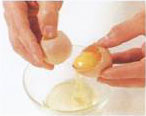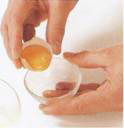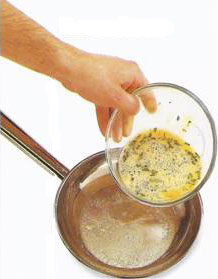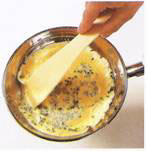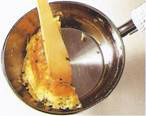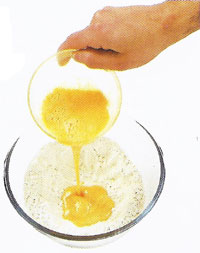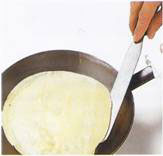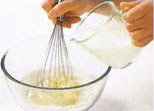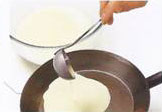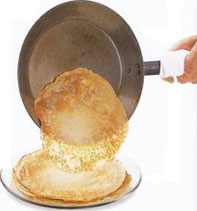 |
|
|
|
|
| Soup | Appetizers | Egg & cheese | Fish & shell fish | Poultry & game | Meat | Vegetables | More ... | |||||||
MICROWAVING
Never microwave an egg that is still in its shell, or it will burst. Even out of its shell, a whole egg may burst, so always pierce the membrane on the yolk before cooking. The yolk cooks more quickly than the white, so standing time should be allowed to let the white continue cooking. Where yolks and whites are combined, as for scrambled eggs, the mixture will appear undercooked but will firm up during standing time. Cheeses melt quickly in the microwave oven, so care must be taken not to overcook or burn them. Hard or firm mature cheeses and processed cheeses are the best to use. Frozen soft ripened cheeses can be softened and brought to room temperature in the microwave oven before serving.
FREEZING
Shelled raw eggs freeze very successfully and can be stored for up to 6 months. If whole, beat gently to mix the yolk and white. Add a little salt to whole eggs and egg yolks for use in savory foods and sugar for use in sweet dishes (nothing needs to be added to whites). Thaw at room temperature. Cooked egg in dishes such as quiches, custard, and mousses can also be frozen. Hard and firm cheeses freeze well, as do soft ripened cheeses such as Brie. Store them for 1 month. Thaw in the refrigerator before use. Note that the texture may change after freezing, making the cheeses suitable only for cooking. Soft fresh cheeses and blue-veined cheeses do not freeze well. BAKING WITH EGGSEggs are used in a variety of dishes to set, thicken, aerate, or emulsify. For most preparations, eggs should be warmed to room temperature before using. This helps maximize the volume if the eggs are beaten, and it will discourage the eggs from curdling, which can occur as a result of any abrupt temperature changes. BOILING 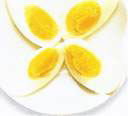 Put the eggs into a pan of boiling salted water (if you use eggs at room temperature, the shells are less likely to crack). Bring back to a boil, then simmer gently. Cooking times are calculated from the time the water comes back to a boil, and can vary according to individual taste and on the freshness of the eggs. For soft-boiled eggs, simmer gently for 3 1/2-5 minutes. For hard- boiled eggs, allow 10-12 minutes, crack to allow steam to escape, then plunge the eggs into ice water and leave to cool. Peel and keep in a bowl of cold water or store, unpeeled, in the refrigerator. FRYING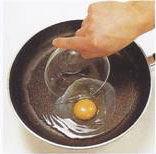 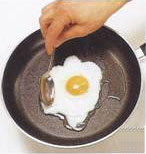 Fresh eggs are essential for successful frying because they keep their shape during cooking. Fry fresh eggs in oil, drippings, or bacon fat, with a little butter added if you like. 1. Heat a thin layer of oil in a heavy skillet. When the oil is very hot and starting to sizzle, slip in an egg and cook over medium heat. 2. Spoon the oil over once or twice to give a white top. Remove and serve or turn over and cook for a few seconds to set the yolk a little more. SCRAMBLING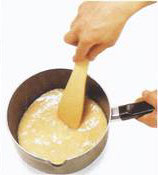 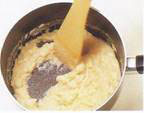 Scrambled eggs can be served plain, or made with herbs, cheese, ham, or smoked salmon. Allow 2 eggs per person. 1. Lightly beat the eggs with salt and pepper to taste and a little milk if you like. Melt a little butter in a pan. Add the eggs. 2. Cook over medium heat, stirring constantly with a wooden spatula or spoon until almost set - the eggs will continue to cook after they have been removed from the heat. Serve at once. POACHING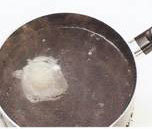 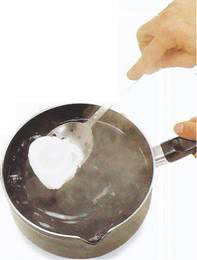 The classic method for poaching eggs is in a pan of simmering water. Adding a small quantity of vinegar to the water prevents the egg white from breaking up. 1. Add 2 tbsp vinegar to a pan of boiling water. Lower the heat so that the water is simmering, and slide in an egg. Swirl the water around the egg to make a neat shape. Simmer for about 4 minutes until yolk is set. 2. Lift out the egg with a slotted spoon and drain briefly on paper towels. To keep poached eggs warm, or to reheat them if they have been prepared ahead of time, immerse them in a bowl of warm water. * * * Salmonella & listeria * * *There is a slight risk of salmonella poisoning from eggs. Listeria bacteria has been found in soft cheeses such as Brie and Camembert, in some blue-veined cheeses and in goat's and sheep's milk cheese. Pregnant women, young children, the elderly, and the immuno-compromised should avoid these cheeses and undercooked eggs, and no one should eat raw eggs. MAKING AN OMELETThese are best made in a special omelet pan kept solely for the purpose. If you don't have one, use a small skillet, about 8 in (20 cm) in diameter.
|






